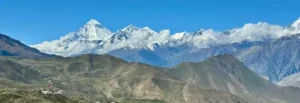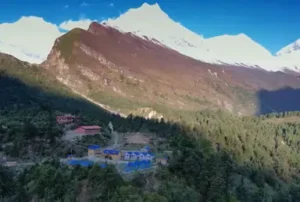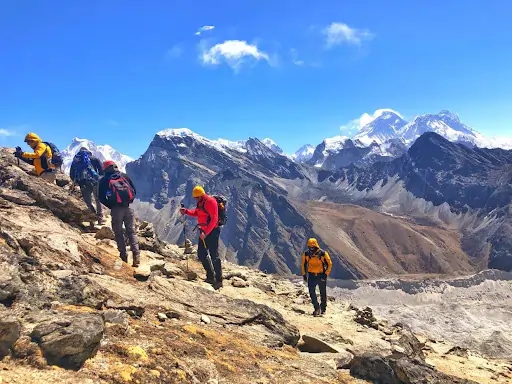Nepal is heaven for hiking. The land full of big mountains, green forests, rivers, and old culture makes it a dream place for trekkers. Everywhere there is some trail going up and down, people smile, and the sky is full of Himalayan peaks. You walk a few days, or many weeks, but your heart always feels full. The best time for hiking in Nepal is mainly autumn (September to November) and spring (March to May). These months the sky is clear, the mountains are shining bright, and the weather is not so cold, not so hot, just perfect. Winter (December to February) is also good for lower treks, but in high altitude snow makes it tough. Summer (June to August) has rain, leeches, and clouds hiding in the mountains, but the valley looks so green and fresh. That’s why most hikers come in autumn and spring when everything blooms, views are amazing, and villages are lively. Nepal has not only one or two treks but many. Some are short, some are long, some are hard, and some are easy, but every one has a story and charm. The most popular and best hiking destinations in Nepal include Everest Base Camp, Annapurna Circuit Trek, and Short Manaslu Trek. Each gives a special feeling, high adventure, and true mountain life.
Everest Base Camp
The Everest Base Camp trek is the world-famous trail, a dream for many. It’s like walking in the sky, surrounded by the tallest mountains on earth. Every step feels like history, because this is the same route where Tenzing and Hillary once walked. People from all over the world come to see the mighty Everest up close and to feel that strong mountain air. The trek starts from Lukla, a small airstrip hanging on a hill. You walk through villages like Phakding, Namche Bazaar, Tengboche, Dingboche, and Lobuche and finally reach Everest Base Camp. You cross hanging bridges, pass by prayer wheels, hear the sound of yak bells, and see monks in red robes. All that makes your soul quiet and happy.
The best time to go on the Everest Base Camp trek is in autumn (September to November) and spring (March to May). These seasons the sky is very clear; you see Mt. Everest, Lhotse, Ama Dablam and many other peaks shine. In winter too you can go, but it is very cold and sometimes snow closes the way. Monsoon is not so good because of flight delays and slippery trails.
This trek takes around 12 to 14 days normally. It’s not easy, but not impossible either. People with a strong heart and some training can do it. The highest point you reach is Kala Patthar, 5545 meters, where sunrise on Everest looks like a golden dream. You stand there breathless, maybe from height or beauty, or both at the same time. The villages give warm food and smiles, and the lodges are simple but cozy. You feel tired but alive; every day you see something new.
The Everest Base Camp trek is not just about mountains; it’s about people too. Sherpa people live there, strong, brave, and humble. You learn about their way of life, their faith in Buddhism, and their love for mountains. Every mani wall and every fluttering prayer flag had meaning. The trail is more than a hike; it’s a journey of mind and heart. When you return back, you are not the same person anymore.
Annapurna Circuit Trek

The Annapurna Circuit Trek is like a full story of Nepal in one trail. It shows you everything—jungle, waterfall, village, high mountain pass, and desert valley. It’s long and full of surprises. Once you start from lower land like Besishahar, the air is hot and full of farms. You walk day by day higher up, see forest change to pine, then rock, then snow. It’s like walking from one world to another. You meet local people, Gurung, Thakali, and Manangi, all with their own culture and food. You eat dal bhat, drink tea, and laugh with them.
The highlight of the Annapurna Circuit is Thorong La Pass, 5416 meters. It’s a tough climb; early in the morning you start in the dark, a cold wind hits your face, but when you reach the top, the whole world opens below. You see Annapurna, Dhaulagiri, Manaslu and many others like a dream. After that you go down to Muktinath, a holy place where both Hindus and Buddhists come. There a fire burns from gas, water flows from 108 taps, and people pray. It’s a special energy there.
The best time for the Annapurna Circuit trek is the same as others—autumn (September to November) and spring (March to May). During these months, there was no rain, no clouds, and the trail was dry. You get a full view of mountains and flowers blooming, and tea houses are busy. Wintertimecold and snow make Thorong La difficult. Summer rain and landslide risk. So autumn and spring are perfect.
The Annapurna Circuit trek takes around 14 to 18 days depending on the route. Now the road reaches some parts, so you can make it shorter if you want. But a full round is always better because you feel every change in nature and culture. You walk along the Marshyangdi River up, then the Kali Gandaki River down. The world’s deepest gorge is here between Annapurna and Dhaulagiri; that’s amazing to see.
This trek is famous because you get everything in one—mountain, valley, desert, forest, culture, and comfort. Tea houses are good, food is tasty, and people are friendly. You can walk alone or with a guide; it is easy to find a way. It’s like one big classroom of the Himalaya, every day teaching something new. When you come back, you understand how Nepal is small but so rich in beauty. Annapurna Circuit always stays in the heart of who walks it.
Short Manaslu Trek

The Short Manaslu Trek is for those who want remote beauty but have less time. The Manaslu area is still pure, not as crowded as Everest or Annapurna. You walk in a wild valley, see tall peaks, cross long suspension bridges, and feel like going back in time. It’s a 10- to 12 day trek, perfect for people who love peace and the mountain both.
The trek starts from Soti Khola or Machha Khola, a small village beside the river. You walk through jungle, bamboo forest, waterfalls, and local Gurung and Tibetan villages. Every turn shows something new. Slowly you go up to Samagaon, where a big view of Mount Manaslu awaits. It’s the eighth highest mountain in the world, at 8163 meters. That view makes you silent. From Samagaon, some go to base camp, and some go to Larke La Pass if time allows.
The Short Manaslu Trek shows real village life. People still live simply, farming animals, with no big road and no big market. You stay in small teahouses, eat local food, hear children laugh, and see old monasteries on a hill. It’s a deep cultural feeling, not only nature. The air is clean, the river cold, and the stars are bright like diamonds. You walk all day and night with the sound of a prayer wheel and wind.
The best time for the Short Manaslu Trek is the same as others—September to November and March to May. These months the weather is stable, the view clear, and the trail open. Winter is too cold, snow closes in, and the monsoon is too wet. Spring is full of rhododendron flowers; the valley looks red and pink, and the mountain white—a perfect photo season. Autumn gives blue sky and golden fields, best for viewing.
The Manaslu area needs a special permit, and you must go with a guide because it’s a restricted zone. That makes it safer and more controlled. The trek is not so hard but requires stamina, because some parts are steep and long. But the reward is big—peace, silence, and nature untouched. The Short Manaslu Trek is like a small gift of the Himalayas for those who don’t like crowds but love beauty.
Why These Treks Are Best in Nepal
These three treks—Everest Base Camp, Annapurna Circuit, and Short Manaslu—are the best because they show the real heart of Nepal. You get high peaks, deep valleys, friendly people, and old culture. Each trek had its own taste. Everest Base Camp is for those who want to reach the world’s top dream. The Annapurna Circuit is for those who love long journeys full of change. Short Manaslu is for those who like quiet trails with mountain magic.
The route in all three gives an amazing view of the Himalaya range—Everest, Lhotse, Ama Dablam, Annapurna, Dhaulagiri, and Manaslu. You see sunrise and sunset color the snow gold and pink. You meet people who live strong lives in hard places and still smile big. You learn respect for mountains and for life itself.
Tea houses, food, and local hospitality make these treks more enjoyable. You eat simple but warm food after a long day, talk with other trekkers, and hear stories from guides. That connection stayed long after the trek finished.
Best Time to Visit for Hiking in Nepal
The best time for all these hiking destinations is autumn and spring. In autumn (September–November) the weather is clean and sky blue, the air is fresh, and there is not much rain. The mountain view is crystal clear. Trails are full of trekkers; it’s festival season in Nepal so villages are colorful. This time is called the golden season.
In spring (March–May) the weather is a little warmer, flowers bloom everywhere, and the rhododendron forest looks like a red carpet. You see birds, butterflies, and still a good mountain view. It’s best for photography and nature lovers.
In winter (December–February), higher places are too cold, snow blocks passes, but lower treks are good because there are fewer crowds and the air is pure. Monsoon (June–August) is not good for high treks because rain and clouds hide peaks, but still you can do some lower region treks.
So autumn and spring are the best times when everything is open, safe, and beautiful.
Tips for Trekkers in Nepal
Always prepare before going. Bring warm clothes, good boots, a rain jacket, and a water bottle. Drink enough water, walk slowly, and don’t rush. High altitude can cause problems, so rest properly and climb gradually. Hire a guide and porter if possible; they know the way and help a lot. Respect local culture, don’t waste food or water, and don’t disturb wildlife.
Carry cash because ATMs are not everywhere. Keep small medicine and energy snacks. Always smile at local people; they smile back. Trekking in Nepal is not only about reaching a destination; it’s about enjoying the way. Every step brings peace and a new view.
Conclusion
Nepal is not just a country; it’s a mountain paradise. From Everest Base Camp to the Annapurna Circuit and the Short Manaslu Trek, every trail is full of wonder. You walk, breathe, climb, and discover yourself. The best time comes in autumn and spring, when the weather is calm and the mountain clear. These treks make you strong inside and out. You meet kind people, cross big rivers, see high peaks, touch the sky, and feel nature very close.
No matter if you are a beginner or an experienced hiker, Nepal has something for you. The Himalaya waits for everyone with open arms and cold wind. After you finish the trek, you carry memories for a lifetime. Once you walk in Nepal, part of you always stays there—in that mountain path, in that sunrise, in that smile of the Sherpa, in that echo of the prayer flag flying high. That’s why people keep coming back, again and again. Nepal is forever home for hikers.
Contact to Escape Himalaya
You Can contact Escape Himalaya by using our email address [email protected] We are available at any time. Escape Himalaya will deliver you price-worthy services, professional guides, trained staff, and assistance on every trip.
Read more: 5 Hidden Gem Wedding Locations in NZ You’ve Probably Never Heard Of – Celebre Buzz
